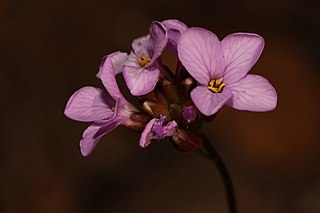
Sex is the trait that determines whether a sexually reproducing organism produces male or female gametes. During sexual reproduction, a male and a female gamete fuse to form a zygote, which develops into an offspring that inherits traits from each parent. By convention, organisms that produce smaller, more mobile gametes are called male, while organisms that produce produce larger, non-mobile gametes are called female. An organism, such as most flowering plants, that produces both types of gamete is a hermaphrodite.

Arabis, or rockcress, is a genus of flowering plants, within the family Brassicaceae.

The Agrostistachydeae is a tribe of the subfamily Acalyphoideae, under the family Euphorbiaceae. It comprises 4 genera, which are monophyletic.

Chrozophoreae is a tribe of plant of the family Euphorbiaceae.

Euphorbieae is a tribe of flowering plants of the family Euphorbiaceae. It comprises 3 subtribes and 5 genera. The 3 sub tribes are: Euphorbiinae, Neoguillauminiinae and Anthosteminae. The 5 genus general are: Argythamnia, Caperonia, Chiropetalum, Ditaxis and Chiropetalum.

Argythamnia is a genus of plants of the family Euphorbiaceae first described as a genus in 1756. They are known commonly as silverbushes.

Caperonia is a genus of plants of the family Euphorbiaceae first described as a genus in 1825. The genus is native to tropical and subtropical America and Africa.
Cavanilla is a name that has been used four times, applied to four different groups of plants. None of the names is in common use today. Names are

Ditaxis is a plant genus of the family Euphorbiaceae first described as a genus in 1824. Its name comes from Greek dis ("two") and taxis ("rank"), referring to the stamens which are in two whorls. The genus is widespread across much of the Western Hemisphere from the southern United States to Uruguay.

Arabis aculeolata is a species of flowering plant in the mustard family known by the common name Waldo rockcress.

Plants are the eukaryotes that form the kingdom Plantae; they are predominantly photosynthetic. This means that they obtain their energy from sunlight, using chloroplasts derived from endosymbiosis with cyanobacteria to produce sugars from carbon dioxide and water, using the green pigment chlorophyll. Exceptions are parasitic plants that have lost the genes for chlorophyll and photosynthesis, and obtain their energy from other plants or fungi.

The Lake Chad flooded savanna is a flooded grasslands and savannas ecoregion in Africa. It includes the seasonally- and permanently-flooded grasslands and savannas in the basin of Lake Chad in Central Africa, and covers portions of Cameroon, Chad, Niger, and Nigeria.

Sphenarches anisodactylus, commonly known as the geranium plume moth, is a species of moth in the family Pterophoridae. It is found in western Africa, Madagascar, India, Sri Lanka, Thailand, Japan, the New Hebrides and Central and South America, as well as Australia, where it has been recorded from Cape York to central New South Wales. It is found in the United States, where it has been recorded from Florida, as well as Mississippi. It is also present in the Kermadec Islands of New Zealand.

Lantanophaga pusillidactyla, the lantana plume moth, is a moth of the family Pterophoridae. It is native to the southern United States, Mexico, the Caribbean, and South America. It was introduced to Australia accidentally in 1936 and is now found from Sydney to Cairns along the coast. It has also been introduced to Hawaii in 1902, Pohnpei in 1948, and Palau in 1960 for biological control. It has since been recorded from Yap in 1987–1988 and is now distributed on all islands of the Mariana and Caroline Islands where the host plant is found, except Aguijan.
Stevensia is a genus of flowering plants belonging to the family Rubiaceae.
Neotorularia is a genus of flowering plants belonging to the family Brassicaceae.

Caperonia palustris is a species of plant, belonging to the genus Caperonia. It is native to tropical and subtropical America and Africa.
Caperonia similis is a species of shrubs in the genus of Caperonia, native to Amazon rainforest.












